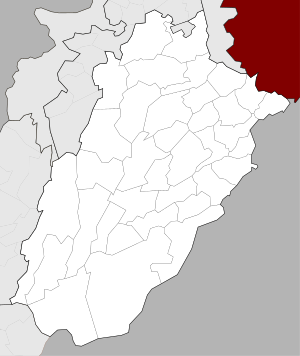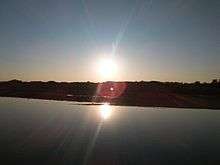Pindigheb
| Pindigheb پنڈی گھیب | |
|---|---|
| City | |
 Pindigheb Location in Punjab, Pakistan  Pindigheb Pindigheb (Pakistan) | |
| Coordinates: 33°14′28″N 72°16′4″E / 33.24111°N 72.26778°ECoordinates: 33°14′28″N 72°16′4″E / 33.24111°N 72.26778°E | |
| Country | Pakistan |
| Province | Punjab |
| District | Attock |
| Tehsil | Pindi Gheb |
| Region | Pothohar |
| Elevation | 310 m (1,020 ft) |
| Time zone | UTC+5 (PST) |
| • Summer (DST) | UTC+6 |
| Area code(s) | 0572 |
| Website | Tehsil Municipal Administration Pindi Gheb |
Pindigheb (or Pindi Gheb) (Urdu: پنڈی گھیب), is a town in Punjab province Pakistan and seat of Pindi Gheb Tehsil (an administrative subdivision) of Attock District.[1] Western route of China Pakistan Economic Corridor (CPEC) passes through Pindigheb.
History
The Imperial Gazetteer of India, compiled over a century ago during British rule, described the town as follows:[2]
| “ | Pindi Gheb Town.-Headquarters of the subdivision and tahsil of the same name in Attock District, Punjab, situated in 33° 14' N. and 72° 16' E., 21 miles from Jand station on the North-Western Railway. Population (1901), 8,452. Historically the name PindGheb is the compound of two words "pind" mean village and "Gheb" derived from the Gheba Rai, or Gheba Khan, the ancestor of the Gheba tribe who came and settled here in 12th century. At the same time the Jodhra tribe settled in this area now the ancestral home of the Jodhra Maliks, who got it in the sixteenth century from their relatives and ancient rivals the Ghebas. The municipality was created in 1873. The income and expenditure during the ten years ending 1902-12 averaged Rs. 4,400. In 1903-4 the income was Rs. 5,200, chiefly from octroi; and the expenditure was Rs. 5,800. A vernacular middle school is maintained by the municipality, and a dispensary by Government. | ” |

In 997 CE, Sultan Mahmud Ghaznavi, took over the Ghaznavid dynasty empire established by his father, Sultan Sebuktegin, In 1005 he conquered the Shahis in Kabul in 1005, and followed it by the conquests of Punjab region. The Delhi Sultanate and later Mughal Empire ruled the region. The Punjab region became predominantly Muslim due to missionary Sufi saints whose dargahs dot the landscape of Punjab region.
After the decline of the Mughal Empire, the Sikh invaded and occupied Attock District. The Muslims faced severe restrictions during the Sikh rule . During the period of British rule, Attock District increased in population and importance.
The predominantly Muslim population supported Muslim League and Pakistan Movement. After the independence of Pakistan in 1947.
Language
The main speech form in Pindigheb is the Hindko dialect Ghebī. In the early 20th century Grierson assigned it to his "North-Eastern Lahnda" group, whereas Shackle writing in 1980 placed it within Hindko "proper" alongside Chacchī and Avāṅkārī.[3]
References
Bibliography
- Shackle, Christopher (1980). "Hindko in Kohat and Peshawar". Bulletin of the School of Oriental and African Studies. 43 (3): 482–510. doi:10.1017/S0041977X00137401. ISSN 0041-977X.
- Gazetteer of Attock 1934